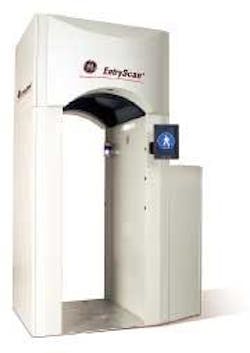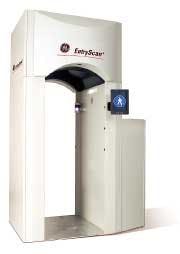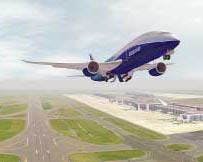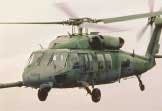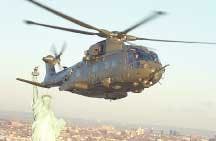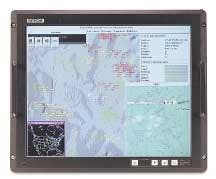Product Applications
Enabling technologies for military and aerospace electronics designers
Sensors
TSA picks GE to supply explosive detectors in airports
Planners at the U.S. Transportation Security Administration (TSA) were looking for explosives trace detection (ETD) equipment to boost airport security. They found a solution at GE Ion Track Inc. in Wilmington, Mass.
TSA planners picked the EntryScan walk-through ETD system, a high-throughput, non-intrusive portal designed to find traces of explosives hidden on people's bodies.
In April 2003, TSA researchers completed laboratory tests of the EntryScan at the Transportation Security Laboratory (TSL) at the William J. Hughes Technical Center in Atlantic City, N.J.
EntryScan's sample collection system takes advantage of a natural airflow phenomenon called the "human convection plume." This eliminates the need for forced air from a fan, which would stir up contaminants, dirt, and dust, and enables relatively clean sample acquisition for sensitive detection.
EntryScan uses GE's patented Ion Trap Mobility Spectrometer (ITMS) technology that detects positive and negative ions to find a broad spectrum of concealed explosives and narcotics contraband.
Another customer, two Canadian power plants, ordered 22 EntryScan portals in February. That contract totals more than 75 units deployed at power plants across the U.S., Canada, and Mexico. Overall, GE built its 100th EntryScan portal in 2003.
For more information contact GE Ion Track by phone at 800-433-5346 or online at www.geindustrial.com.
Computers
Boeing chooses Honeywell for 7E7 avionics
Engineers at Boeing in St. Louis, Mo. needed two avionics systems for their new 7E7 Dreamliner airplane: a navigation package and a crew information system/management system. They found solutions for both at Honeywell Aerospace in Phoenix.
The navigation package is a bundle of systems that measure aircraft performance, acceleration, speed, and altitude, as well as handle ground- and satellite-based navigation.
The crew information system/management system (CIS/MS) allows the pilot to measure the health of all major onboard systems. Together, the two new components represent a $1.5 billion contract for the company, over the lifetime of the 7E7.
The 7E7 Dreamliner is designed to merge big-jet range with small-jet efficiency, Boeing spokesmen say. It will carry 200 to 250 passengers on routes between 7,800 and 8,300 nautical miles, while burning 20 percent less fuel than other wide-body airplanes.
For more information contact Honeywell by phone at 800-601-3099 or online at www.honeywell.com.
Power electronics
Leach International to provide specialized relays for commercial aircraft
Electronics designers at The Boeing Co. in Seattle needed specialized relays to satisfy FAA safety regulations in upgrades of the Boeing 727, 737, 747, 757, 767, and 777 commercial aircraft, as well as the DC-10, MD-10, and MD-11 jetliners.
They found their solution in the fault current detection and ground fault interrupt relays from Leach International Corp. in Buena Park, Calif.
FAA regulation SFAR 88 requires transport-category aircraft manufacturers to modify fuel systems to eliminate the possibility of an ignition source developing within a fuel tank.
The Leach ground fault interrupt relays sense fuel pump and ground faults, while the company's fault current detection relays sense fuel pump ground faults and phase-to-phase short circuits in the fuel pump and upstream wiring, company officials say.
Leach engineers use a proprietary circuit design in their fault current detection and ground fault interrupt relays to detect these faults and open the circuit within milliseconds to keep the potential of fuel fires to a minimum.
The Leach relays have a built-in test that enables aircraft mechanics to verify that fault sensing is activated. In addition, a visual trip indicator located on the devices alerts maintenance personnel that a ground fault has occurred.
For more information contact Leach International by phone at 714-736-7598, or online at www.leachintl.com.
Board products
ACM Systems chooses FPGA-based processor boards from Spectrum Signal Processing
Systems designers at ACM Systems, an electronic warfare and training-range instrument manufacturer in Rancho Cordova, Calif., needed software-reconfigurable processor boards for high-speed signal processing.
They found their solution in the flexComm HCDR-1001 family of software reconfigurable platforms from Spectrum Signal Processing in Burnaby, British Columbia.
"ACM Systems requires a high-performance field programmable gate array (FPGA)-based signal processing platform," says Tim Black, president and chief operating officer at ACM Systems. ACM is a subsidiary of Sierra Nevada Corp. in Sparks, Nev.
"Spectrum's HCDR platform provides an ideal technical solution on the basis of flexibility, scalability, and processing power," Black says. "In addition, Spectrum's technical integration support has allowed us to start development faster and will also help to ease our development effort."
The flexComm HCDR-1001 configuration for ACM Systems is VME-based and uses high-performance FPGAs from Xilinx Inc. in San Jose, Calif., and PowerPC processors from Motorola Inc. in Austin, Texas, for high-bandwidth signal processing.
A dual Race++ interface and Spectrum's Solano-based communications fabric enable high-speed communications between the boards and processors, Spectrum officials say.
For more information contact Spectrum Signal by phone at 604-421-5422, or online at www.spectrumsignal.com.
Simulation equipment
Navy chooses Lockheed Martin for helicopter maintenance trainer
Engineers at the U.S. Navy needed a way to teach repair technicians how to service MH-60S Knighthawk and MH-60R Strikehawk helicopters. They found a solution in the Avionics Maintenance Trainer (AMT 2), from Lockheed Martin.
The trainer consists of a partial MH-60 helicopter airframe outfitted with a combination of real and simulated avionics hardware. An instructor at a workstation nearby can trigger avionics system faults that technicians must find and correct.
"The AMT 2 will help the Navy fulfill its objective of maintaining readiness and maximizing available flight hours in the MH-60 fleet," said Jeff Bantle, vice president of Multi-Mission Solutions at Lockheed Martin Systems Integration – Owego. "Technicians working in the AMT 2 will learn avionics maintenance via a virtual duplicate of an actual MH-60S or MH-60R avionics system, which will help them to make repairs quickly and confidently in the field."
Navy trainers already use a similar trainer called the AMT 1, outfitted only for the MH-60S. The AMT 2 will duplicate both types of helicopter. The $10.9 million trainer is scheduled to be in service at the North Island Naval Air Station in San Diego, Calif., by August, 2005.
Lockheed Martin also provides the common cockpit for both aircraft, including devices such as displays, digital communications, common programmable key sets, integrated global positioning system, inertial navigation system, mass memory data storage, and mission computer.
For more information contact Lockheed Martin by phone at 407-306-6861 or online at www.lockheedmartin.com.
Software
Helicopter fly-by-wire system to use BAE real-time operating system
Avionics designers at Sikorsky Aircraft Corp. in Stratford, Conn., needed real-time operating system (RTOS) software to run the fly-by-wire flight-control systems aboard the company's S-92 and H-92 helicopters.
The CsLEOS real-time operating system from BAE Systems Aerospace Controls in Johnson City, N.Y., met their needs.
"The operating system that runs an aircraft flight-control computer must be exceptionally robust," says Milan Dedek, CsLEOS product manager for BAE Systems. "Our system was developed specifically for use on flight controls and other mission-critical aircraft systems."
The S-92 and H-92 fly-by-wire flight control will consist of flight-control computers, pilot control sticks, and sensors for processing aircraft pitch, roll, and yaw data. The embedded CsLEOS RTOS will operate the flight-control computers, BAE officials say.
BAE Systems will develop and produce the flight-control system at its facility in Johnson City, N.Y.
CsLEOS complies with the safety-critical ARINC-653 standard, and was designed from the ground up for safety- and mission-critical applications that require predictable real-time response and testability, BAE officials say.
The RTOS uses hardware memory protection, and provides time, space, and resource partitioning between the kernel and applications operating on the same hardware platform. It also ensures resource availability in the time and space domains, company officials say.
This combination helps partition tasks as defined in ARINC 653, enabling applications with different DO-178B safety levels to run concurrently on the same processor. CsLEOS also supports "on-the-fly" application rescheduling.
To ensure fast recovery for time-critical events, CsLEOS synchronizes all redundant channels on a frame-by-frame, lock-step basis to keep all channels processing the same data concurrently. In the event of a fault on one of the channels, the RTOS restarts the channel within milliseconds.
For more information contact BAE Systems Aerospace Controls by phone at 607-770-2000, or online at www.baesystems.com.
Communications equipment
Navy turns to Harris for long-range HF radios
Communications experts at the U.S. Space and Naval Warfare Systems Command (SPAWAR) in San Diego needed new high-frequency (HF) radios for U.S. Navy surface ships. They found their solution from the Harris RF Communications Division in Rochester, N.Y.
Harris officials are providing SPAWAR with their company's Falcon(R) II line of software-defined HF radios under terms of a $12 million indefinite delivery indefinite quantity (IDIQ) contract with a ceiling price of $41 million.
Harris will supply HF broadband communications systems for Navy warships, including San Antonio–class amphibious transport ships, Arleigh Burke–class guided missile destroyers, Nimitz-class aircraft carriers, and Ticonderoga-class guided missile cruisers.
This is the third contract Harris RF Communications has received to provide radio systems in support of the Navy's effort to update the HF systems of its fleet.
The High Frequency Radio Group (HFRG) at Harris RF Communications is offering the Navy a set of HF communications building blocks that can be configured to satisfy a variety of naval platforms.
Harris radio designers will use their experience with configuring elements such as receiver and exciters, power amplifiers, couplers, and controllers in this modular system to support the concepts and goals in the Joint Tactical Radio System Airborne, Maritime, Fixed Station (JTRS AMF) procurement.
For more information contact Harris RF Communications by phone at 585-244-5830, or online at www.rfcomm.harris.com.
Communications equipment
Group chooses Palomar for communications on Marine One helicopters
TeamUS101 needed a secure communications system for the US101 medium-lift executive aircraft. They found a solution at Palomar Products of Rancho Santa Margarita, Calif.
TeamUS101 is a group of vendors that are designing an American variation of AgustaWestland's EH101 helicopter, intended for use in combat search and rescue. They are also competing for a contract to build the next-generation fleet of Marine One helicopters to carry the U.S. President.
The group includes Lockheed Martin (prime contractor and systems integration), AgustaWestland (aircraft design), and Bell Helicopter Textron (airframe assembly). For more information see www.teamus101.com.
Palomar will build a secure intercommunications system that meets U.S. military crosstalk isolation standards for preventing other sources from eavesdropping on voice transmissions. The company builds a similar system for current Marine One helicopters.
"The exceptional performance record of Palomar's secure intercommunications systems across multiple Marine, Navy and Air Force platforms, coupled with the US101 platform's proven operational success, provides the Marine One squadron optimal reliability and low risk in a helicopter system to serve the office of the president," said Stephen D. Ramsey, Lockheed Martin's US101 vice president and general manager.
For more information contact Palomar Products by phone at 949-766-5300 or online at www.palpro.com.
Sensors
Army chooses Sporian and Phase IV to build water sensor
Engineers at the U.S. Army Corps of Engineers, in Alexandria, Va., needed a sensor to detect pathogens in drinking water. They found an answer at Sporian Microsystems Inc. and Phase IV Engineering, of Boulder, Colo.
Army planners awarded a contract to develop a wireless sensor to monitor drinking water supplies for potability and the presence of hazardous pathogens. The sensor would ensure the safety of domestic populations and of soldiers abroad.
The sensor must be able to detect three common pathogens — Cholera, Giardia, and E. coli. It will achieve that goal through Sporian's combination of molecular biology, optics, and microelectronics packaging.
If the sensor finds a bug, it will fire a signal through Phase IV's wireless radio frequency (RF) system. A network of these systems would communicate with each other, and send contamination alarms to a central monitoring station via satellite signal.
"The idea is that the sensor can be remotely placed in a reservoir, water treatment facility, etc., and in the event of a detection the unit will call the appropriate authorities," says Kevin Harsh, the Sporian project lead.
The sensor network will be so flexible that future applications could include testing for airborne and waterborne biological or chemical agents.
For more information contact Sporian Microsystems by phone at 303-516-9075 or online at www.sporian.com, or contact Phase IV Engineering by phone at 303-443-6611 or online at www.phaseivengr.com.
Integrated circuits
Rad-hard FPGAs from Actel help run Mars rovers
Space systems designers working under supervision of the NASA Jet Propulsion Laboratory in Pasadena, Calif., needed radiation-hardened field programmable grate arrays (FPGAs) for the current robotic exploration of Mars. They found their solution from Actel Corp. in Mountain View, Calif.
Actel officials say their company's radiation-tolerant and radiation-hardened FPGAs are playing important roles throughout the Mars mission, from Delta launch vehicles to orbiting, landing, and actively roving the surface of Mars.
Actel has provided "hundreds of FPGAs" that support the Mars mission to implement mission-critical digital logic functions such as power management, attitude and orbit control, command and data handling, instrumentation, and telemetry, Actel officials say.
The space-optimized Actel FPGAs are nonvolatile, have proven reliability at extreme temperatures, and live at power-up functionality — all on one chip, which reduces component count, thereby minimizing power consumption and saving board space and weight, officials say.
The Actel radiation-tolerant and radiation-hardened devices provided critical functions on the Delta launch vehicles, which propelled the Spirit and Opportunity spacecrafts toward Mars. During the six-month flight from Earth to Mars, Actel's devices functioned on central system computers, performing navigation activities, including star tracking and sun sensing.
On each of the Mars Explorer Rovers, Actel's space FPGAs help run the 10 cameras, which capture images of the planet's surface. The devices also enable key radio communications, which relay those images back to the orbiters.
For more information contact Actel by phone at 888-992-2835, or online at http://www.actel.com.
Displays
Kongsberg chooses Barco display for air defense
Engineers at Norwegian contractor Kongsberg Defence and Aerospace needed a flat-panel display for tactical air defense systems in several NATO countries. They found a solution at Barco in Kortrijk, Belgium.
Kongsberg engineers are building the NASAMS (Norwegian Advanced Surface to Air Missile System) and HAWK air defense programs for operational decision-making in ground-based command-and-control shelters.
To display all the graphics, they picked Barco's RFD251/II display, a 19-inch rack-mountable, touch-screen flat-panel display with ruggedized HumiSeal coating. Each screen has a 20.1-inch liquid-crystal-display screen with 1280-by-1024-pixel resolution.
Planners at Kongberg have ordered 180 of the displays, and received four units so far. They will continue to receive shipments through mid-2005.
For more information contact Barco's U.S. office by phone at 916-859-2500 or online at www.barco.com.
Communications equipment
Washington chooses Motorola and Flarion for wireless network
Emergency planning officials in the District of Columbia needed a high-speed wireless broadband data network to link their police and fire networks. They found a solution in a partnership between Flarion Technologies in Bedminster, N.J., and the Motorola Radio Systems Division in Schaumburg, Ill.
The program includes installation, testing, and operations of the network for a year. The new system will rely on 10 transmission sites to provide citywide coverage for first responders. For more information, see www.octo.dc.gov.
"This network will enable significant new capabilities — link hospitals and ambulances with real-time video, download mug shots to officers in the field, or even convey the detection of a chemical weapons attack via wireless devices," says Suzanne Peck, chief technology officer of the District of Columbia.
The District government is part of the Spectrum Coalition for Public Safety, a group that advocates for state and local officials to reserve spectrum in the 700-MHz band for first responders in all jurisdictions. The D.C. network is to be operational by the summer of 2004.
For more information contact Flarion Technologies by phone at 908-947-7000 or online at www.flarion.com, or contact Motorola by phone at 888-567-7347 or online at www.motorola.com.
